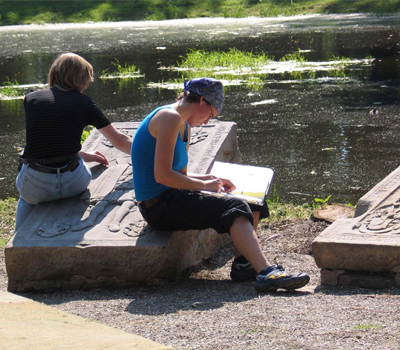The German Inscriptions of the Middle Ages and the Early Modern Age
Links to the project
Medieval and early modern inscriptions crafted before 1650, in Latin and German language, situated in German-speaking areas are at the heart of this project. Inscriptions are significant and unique historical sources because they are often preserved in an authentic state and in their original setting. For the premodern era, script which was affixed to stone, wood, metal, glass as well as textiles or leather offers a significant enrichment to historical information written by hand or printed on paper and parchment. Likewise, most inscriptions are characterized by a wider and longer lasting public presence – a fundamental factor which influenced their design and production. This applies to inscriptions on funeral monuments, church bells and buildings as well as on church fittings such as altars, reliquaries, chalices, offertory boxes, pulpits and baptismal fonts.
 The German Inscriptions of the Middle Ages and the Early Modern Age
The German Inscriptions of the Middle Ages and the Early Modern AgeThe German Inscriptions of the Middle Ages and the Early Modern Age
Host Academy
Saxon Academy of Sciences and Humanities in Leipzig
Academy of Sciences and Literature, Mainz
Heidelberg Academy of Sciences and Humanities
Göttingen Academy of Sciences and Humanities in Lower Saxony
Bavarian Academy of Sciences and Humanities
North Rhine-Westphalian Academy of Sciences, Humanities and the Arts
Location and federal state
Heidelberg, Baden-Württemberg; Munich, Bavaria; Göttingen, Lower Saxony; Bonn, North Rhine-Westphalia; Mainz, Rhineland-Palatinate; Dresden, Saxony; Halle, Saxony-Anhalt; Greifswald, Mecklenburg-Vorpommern; Mainz, Hesse; Jena, Thuringia
Type
Editions: Epigraphy and Onomastics
Project number
II.F.01-1-11
The critical and commented editions do not only feature inscriptions which have come down to us in their original state but also those lost and therefore only known by means of older transcriptions or photographs. The focus of the edition lies on a letter-by-letter transcription of the originals which are often difficult to discern and decipher. The transcription is supplemented by a description of the artefact on which the inscription is placed. In many cases these artefacts are of high art-historical value. To give a complete picture, information regarding the original location and setting is also provided. These data contribute to an extensive understanding of text and object in time and space. All Latin, Greek and older German texts are translated, and various matters concerning the inscriptions and their support are discussed. Another essential aim of the project, next to the presentation of epigraphic texts, is to provide material for a paleography of inscriptions. By studying individual letter forms, the time of origin for undated objects as well as workshop networks can be reconstructed.
Since 2012, the project has been working with a revised concept for Germany. The goal is to make the cultural heritage as transmitted in inscriptions available by establishing corpuses as representative case studies of major issues of cultural history (e.g. imperial cities, residences, monastic landscapes).
The printed volumes of the series “Die Deutschen Inschriften” [German Inscriptions] not only provide important source material for scholars in many fields of the humanities but also appealing reading material for non-professionals interested in the history of their town or region. In addition, since 2009 more than 40 volumes and additional publications have been made available as open-access publications on Deutsche Inschriften Online (http://www.inschriften.net/), in a version enhanced by numerous images and continuously updated by addenda and corrigenda.
Back to overview
